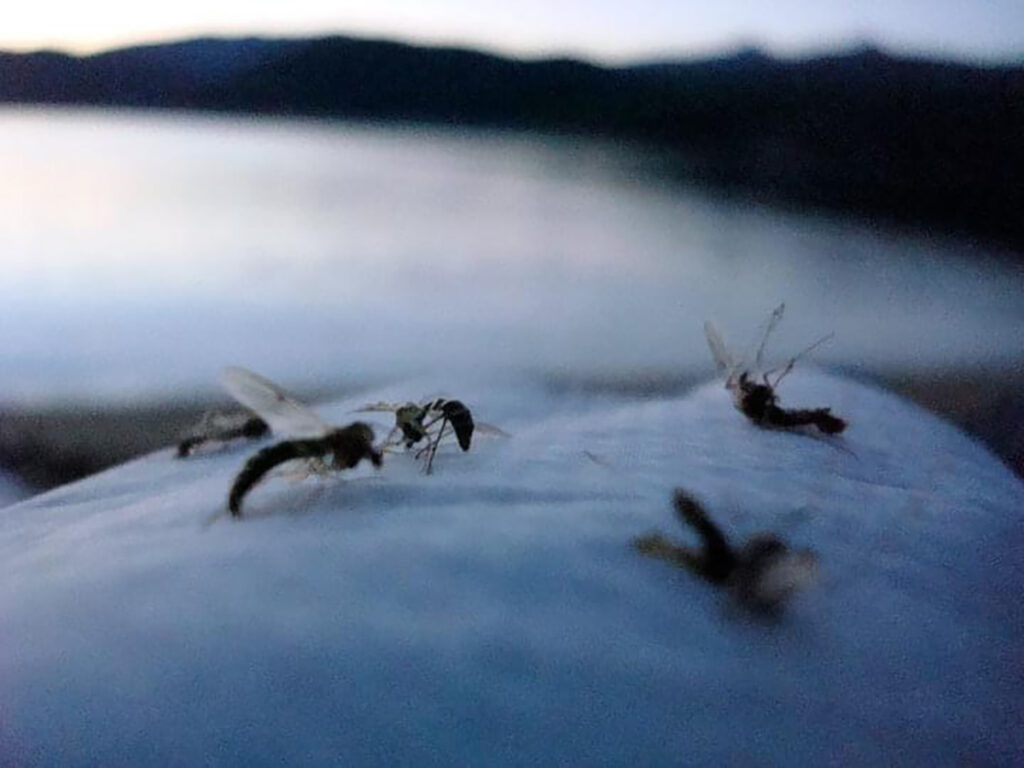Cover photo courtesy Shallan Knowles
Permethrin, picaradin, DEET, bracelets, candles, lotions, sprays. All I know at 11 p.m. when they whine past my ear and I smack my tentmate in the chest with my headlamp for the fifth time, trying to squash them before they gorge themselves on my blood, is that I. Hate. Mosquitoes.
My significant other isn’t bothered by mosquitoes. They sometimes bite him, but rarely, and when they do, he says it doesn’t itch. I, on the other hand, am ready to murder someone by the third bite as it swells, gets red, and itches (sometimes for days!). He says it’s because I use bug repellant and he doesn’t, that the chemicals are actually an attractant. But the science seems to indicate that I just smell better. And I’m hotter. To mosquitoes, anyway.
Mosquitoes are drawn to body heat, exhaled CO2, and kairomones–chemical signals that attract one species to another, for the benefit of the former. These kairomones are sensed using olfactory (smell) receptors. And mosquitoes have olfactory receptors that can sense carbon dioxide, lactic acid, ammonia, organic fatty acids, ketones, aldehydes, alcohols, and esters. The combinations of those smells are a strong attractant for them. There are many other factors at play as well, such as one’s number of skin glands, skin pH, metabolic rate, body mass, one’s breathing rate and intensity, as well as the microbes living on one’s skin.
Figuring out the right solution to protect your flesh, blood, and sanity gets more confusing all the time. After some research, though, here’s my take on the 411 for avoiding these tiny terrorists on your next outdoor adventure.

Permethrin
Uses: A spray or wash-in option for clothes, footwear, tents, sleeping bags… any outer fabric that will be joining you on your trip. The treatment will last through several washes and is a staple for international travelers headed to places where malaria is common. Permethrin is the main ingredient used in clothing that is sold touting insect repellency.
Pros: The treatment can be done ahead of time. Once fabric is treated and dry, there is no odor. It repels not just mosquitoes, but most other bugs as well. It doesn’t typically damage technical fabrics.
Cons: The spray or wash is toxic to pets when it’s wet. It can be difficult to ensure thorough coverage with the spray and may take more than one treatment. Manufacturers recommend washing permethrin-treated clothing separately from other clothes, since it is designed for outer fabrics and should be kept away from other articles of clothing like underwear.
Picaridin
Uses: Picaridin was developed in the 1980s as a less offensive-smelling option to DEET. It is available in sprays, creams, and wipes. It’s touted as a synthetic compound that mimics substances in plants used to produce black pepper. It’s believed that picaridin works by blocking insects’ ability to sense their prey, but it doesn’t kill insects.
Pros: It’s odorless. Well, not completely (in my opinion), but almost. Very little of it absorbs through the skin. That which makes it through comes out in urine. Picaridin doesn’t damage clothing and lacks the sticky residue of typical bug repellants.
Cons: It is mildly toxic to fish. Because it has only been approved in the US since the early 2000s, it’s not as readily available as its prime competitor, DEET. And, in my experience . . . it doesn’t work on mosquitoes.
DEET
Uses: This tried-and-true anti-bug chemical has been used for years to keep the skeeters at bay. It comes in sprays, creams, and wipes. But not all DEET-bearing products are created equal. Many products splash “DEET” all over their label, but ultimately contain only 30% of the insect-fighting substance, padding the rest with alcohol or additives that try to mask the caustic smell reminiscent of endless summer nights, sticky sleeping bags, and burnt marshmallows.
Pros: Simply put, mosquitoes hate it. Even Yellowstone mosquitoes. Even Great Lakes mosquitoes. Even (dare I say it?) Alaskan mosquitoes! They sell it everywhere, so when you run out (like on a kid-friendly, overnight bikepacking trip to Harrison on the Trail of the Coeur d’Alenes), it’s easy to replenish.
Cons: It stinks! It’s easy to understand why the bugs hate it. No one likes it. No one! And it’s sticky. Once you spray it on, you’re committed to being camp-sticky, and stinky, in a big way until your next shower. It can degrade and discolor technical fabrics. You know, like your tent, your hiking boots, your top-of-the-line zip-off hiking pants, and the promotional logos on your swag freebie sunglasses. Some people also have lingering concerns about potential health risks from using DEET, even though the widely-used product has a long track record as a safe and effective topical mosquito repellent.
While there are plenty of other bug repellant options on the market, from coils to bracelets, crystals, seances, and the blood of a goat, I’m not going to justify those options with space in this magazine. They don’t work. And while you either love or hate DEET, it’s the one thing that reliably keeps the wicked bloodsuckers away, and the only thing I trust with my delicate porcelain peel.
Carol Corbin commits the first 5-10 minutes of every overnight stay in a tent to hunting mosquitoes with all available light sources, and once carried the slaughtered carcass of a Yellowstone mosquito on her kayak for a full day, just to deter other would-be bloodsuckers from attacking.













